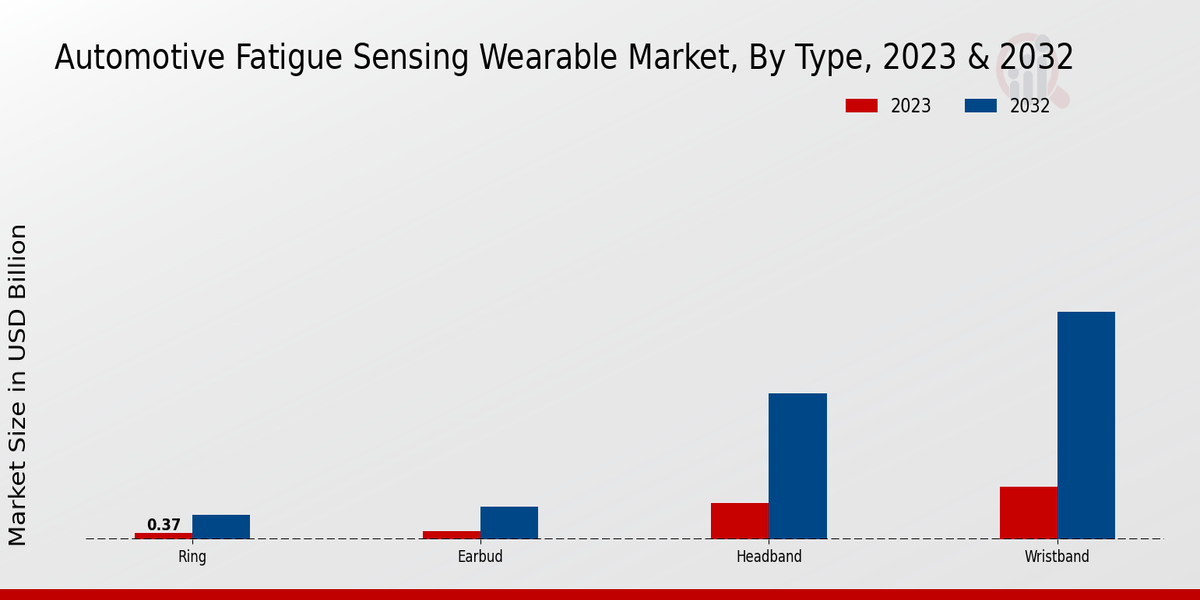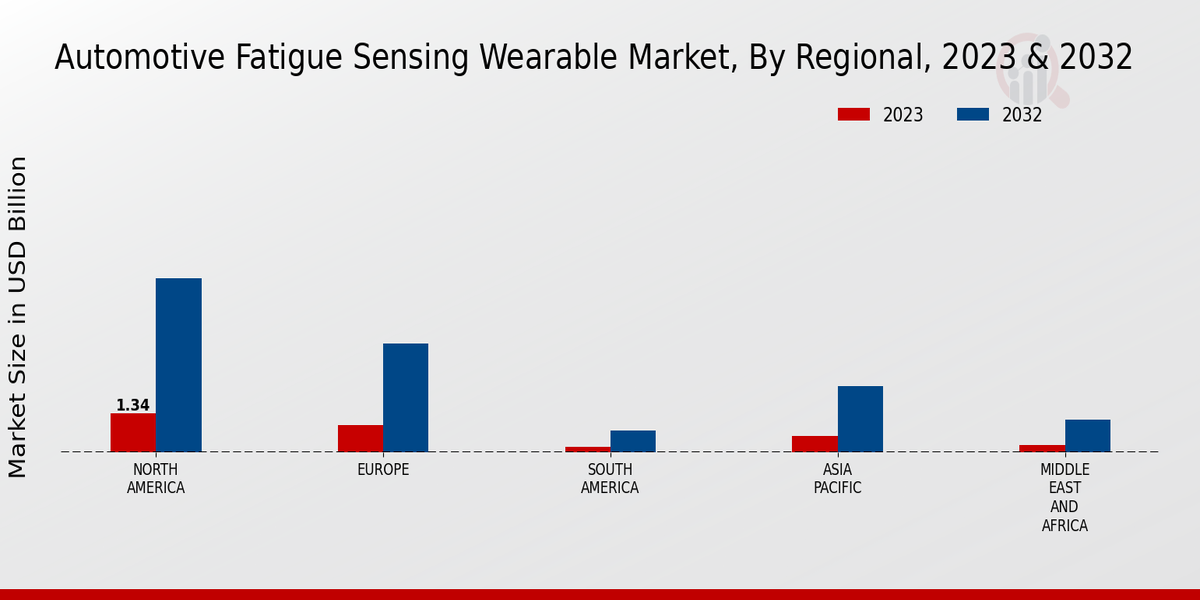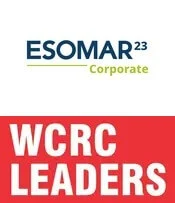Global Automotive Fatigue Sensing Wearable Market Overview:
As per MRFR analysis, the Automotive Fatigue Sensing Wearable Market Size was estimated at 5.06 (USD Billion) in 2024. The Automotive Fatigue Sensing Wearable Market Industry is expected to grow from 5.91 (USD Billion) in 2025 to 23.84 (USD Billion) till 2034, at a CAGR (growth rate) is expected to be around 16.76% during the forecast period (2025 - 2034)
Key Automotive Fatigue Sensing Wearable Market Trends Highlighted
The increasing prevalence of automotive accidents caused by driver fatigue has spurred the demand for fatigue-sensing wearables in the automotive industry. The growing adoption of advanced driver assistance systems (ADAS) and autonomous driving technologies is expected to further drive the market growth.
Opportunities for market expansion lie in the development of wearable devices with enhanced sensing capabilities, data analytics, and integration with vehicle systems. The integration of artificial intelligence (AI) and machine learning algorithms can improve the accuracy and reliability of fatigue detection, leading to enhanced driver safety. Furthermore, government regulations and initiatives aimed at reducing distracted driving and improving road safety are also expected to drive market growth in the coming years.

Source: Primary Research, Secondary Research, MRFR Database and Analyst Review
Automotive Fatigue Sensing Wearable Market Drivers
Increasing Demand for Enhanced Safety Features in Vehicles
The growing awareness of road safety and the stringent government regulations mandating the integration of advanced safety features in vehicles are driving the demand for automotive fatigue sensing wearables.
These devices offer real-time monitoring of driver fatigue levels, enabling timely interventions to prevent accidents. The rising incidence of road accidents attributed to driver fatigue has spurred the adoption of fatigue sensing wearables, as they provide an effective means to enhance vehicle safety and reduce the risk of collisions.
Technological Advancements and Innovation
The Automotive Fatigue Sensing Wearable Market is witnessing significant technological advancements, leading to the development of more sophisticated and accurate fatigue sensing devices. The integration of advanced sensors, such as electroencephalography (EEG) and electrocardiography (ECG), enables precise monitoring of brain activity and heart rate variability, providing a comprehensive assessment of driver fatigue levels. Furthermore, the advent of artificial intelligence (AI) and machine learning algorithms enhances the accuracy and reliability of fatigue detection, contributing to the growing adoption of these devices.
Government Regulations and Initiatives
Stringent government regulations and initiatives mandating the implementation of fatigue management systems in commercial vehicles are driving the growth of the Automotive Fatigue Sensing Wearable Market. Regulatory bodies worldwide are recognizing the importance of addressing driver fatigue as a critical safety issue, leading to the enactment of laws and regulations that require the use of fatigue sensing devices in certain vehicle categories. These regulations are primarily focused on promoting road safety and reducing the incidence of accidents caused by driver fatigue.
Automotive Fatigue Sensing Wearable Market Segment Insights:
Automotive Fatigue Sensing Wearable Market Type Insights
The Automotive Fatigue Sensing Wearable Market is segmented by Type into Headband, Wristband, Earbud, Ring, and Others. The Wristband segment is expected to hold a dominant share of the market in 2023. Wristbands are a popular form factor for fatigue sensing wearables due to their convenience and comfort. They are also relatively inexpensive to produce, which makes them a more accessible option for consumers. The Headband segment is expected to grow at a significant rate during the forecast period. Headbands are becoming increasingly popular as a form factor for fatigue sensing wearables due to their ability to provide more accurate and reliable data than other form factors.
The Earbud segment is also expected to experience significant growth during the forecast period. Earbuds are a convenient and discreet form factor for fatigue sensing wearables, which makes them ideal for use in a variety of settings. The Ring segment is expected to account for a smaller share of the market, but it is still expected to grow at a steady rate during the forecast period. Rings are a relatively new form factor for fatigue sensing wearables, but they offer a number of unique advantages, such as their ability to be worn continuously and their ability to track sleep patterns.
The Others segment includes other form factors for fatigue sensing wearables, such as glasses and patches. The growth of the market is attributed to the increasing demand for fatigue sensing wearables in the automotive industry. Fatigue is a major safety concern in the automotive industry, and fatigue sensing wearables can help to prevent accidents by alerting drivers when they are becoming fatigued. The market is also expected to benefit from the growing adoption of wearable technology in general. Wearable technology is becoming increasingly popular as a way to track health and fitness, and fatigue sensing wearables are a natural extension of this trend.

Source: Primary Research, Secondary Research, MRFR Database and Analyst Review
Automotive Fatigue Sensing Wearable Market Modality Insights
The Modality segment of the Automotive Fatigue Sensing Wearable Market is expected to grow significantly in the coming years. The market is segmented into Electroencephalogram (EEG), Electrocardiogram (ECG), Electromyography (EMG), and Others. EEG-based devices measure brain activity to detect fatigue levels. ECG-based devices measure heart rate and heart rate variability to assess fatigue.
EMG-based devices measure muscle activity to detect fatigue. Other modalities include eye-tracking, voice analysis, and thermal imaging. The EEG segment is expected to hold the largest share of the market in 2023 and is projected to continue to dominate the market over the forecast period.
This is due to the high accuracy and reliability of EEG-based devices in detecting fatigue. The ECG segment is expected to grow at the fastest rate over the forecast period, due to the increasing adoption of ECG-based wearables in the automotive industry. The key players in the Automotive Fatigue Sensing Wearable Market include BrainCo, Cognixion, Emotiv, Fatigue Science, and NeuroSky. These companies are investing heavily in research and development to improve the accuracy and reliability of their devices.
Automotive Fatigue Sensing Wearable Market Application Insights
The automotive fatigue sensing wearable market segmentation by Application includes Driver fatigue monitoring, Worker fatigue monitoring, Pilot fatigue monitoring, and Others. The Driver fatigue monitoring segment is expected to hold the largest market share in 2023, owing to the rising concerns regarding road safety and the increasing adoption of fatigue sensing wearables by commercial fleet operators. The Worker fatigue monitoring segment is also expected to witness significant growth in the coming years, driven by the growing awareness of workplace safety and the need to improve productivity.The Pilot fatigue monitoring segment is expected to grow at a steady pace, driven by the increasing adoption of fatigue sensing wearables by airlines and the stringent regulations regarding pilot fatigue management. The Others segment includes applications such as military and healthcare and is expected to witness moderate growth in the coming years.
Automotive Fatigue Sensing Wearable Market End User Insights
The Automotive Fatigue Sensing Wearable Market is segmented based on End User into Professional Drivers, Industrial Workers, Pilots, and Others. Among these segments, Professional Drivers are expected to hold the largest market share in 2023, accounting for nearly 40% of the Automotive Fatigue Sensing Wearable Market revenue.
The high adoption of fatigue sensing wearables among professional drivers is attributed to the increasing awareness of driver fatigue and its impact on road safety. Industrial Workers are expected to be the second-largest segment, followed by Pilots and Others.
The market for Automotive Fatigue Sensing Wearables is expected to grow significantly in the coming years, driven by the increasing adoption of advanced driver assistance systems (ADAS) and the growing awareness of the importance of driver safety.
Automotive Fatigue Sensing Wearable Market Battery Life Insights
The Battery Life segment is a crucial aspect of the Automotive Fatigue Sensing Wearable Market segmentation. It plays a significant role in determining the user experience and product adoption. The segment can be categorized into three primary sub-segments: 'Less than 8 hours', '8-12 hours', and 'More than 12 hours'.
The 'Less than 8 hours' sub-segment caters to devices with shorter battery life, typically lasting less than 8 hours on a single charge. This sub-segment holds a notable market share, as it offers a convenient and portable option for users who require quick and frequent charging.
However, its limited battery life may not be suitable for extended use or long-distance travel. The '8-12 hours' sub-segment represents devices with moderate battery life, providing 8 to 12 hours of usage on a single charge. This sub-segment holds a significant market share, as it offers a balance between portability and extended usage. It caters to users who need their devices to last throughout the day without the need for frequent charging.
The 'More than 12 hours' sub-segment encompasses devices with extended battery life, lasting more than 12 hours on a single charge. This sub-segment is gaining popularity among users who demand long-lasting devices that can support extended use without interruptions. The increasing adoption of advanced battery technologies is driving the growth of this sub-segment.
Automotive Fatigue Sensing Wearable Market Regional Insights
The automotive fatigue sensing wearable market is segmented into regions like North America, Europe, APAC, South America, and MEA. Among these, North America holds the largest share due to the increasing awareness about road safety and technological advancements.
Europe stands second with stringent government regulations regarding driver safety. APAC is witnessing rapid growth with emerging economies investing in automotive infrastructure. South America and MEA hold relatively smaller shares but have potential for growth in the coming years.

Source: Primary Research, Secondary Research, MRFR Database and Analyst Review
Automotive Fatigue Sensing Wearable Market Key Players and Competitive Insights:
Major players in the Automotive Fatigue Sensing Wearable Market are constantly striving to improve their products and services to gain a competitive edge. Leading Automotive Fatigue Sensing Wearable Market players are focusing on developing new technologies, expanding their product portfolio, and entering strategic partnerships to strengthen their position in the market.
The automotive fatigue sensing wearable market is witnessing a trend towards increased adoption of wearable devices, due to the growing awareness about the importance of health and well-being. This has led to a surge in demand for Automotive Fatigue Sensing Wearable, as they offer a convenient and non-intrusive way to monitor fatigue levels.
The market is also expected to benefit from the increasing adoption of connected devices and the Internet of Things (IoT). This is because Automotive Fatigue Sensing Wearable can be easily integrated with other devices, such as smartphones and fitness trackers, to provide a more comprehensive view of the wearer's health and well-being.
One of the leading companies is Apple. Apple is known for its innovative and user-friendly products, and its Automotive Fatigue Sensing Wearable are no exception. Apple's Automotive Fatigue Sensing Wearable are designed to be comfortable and easy to wear, and they offer a variety of features to help users monitor their fatigue levels. These features include heart rate monitoring, sleep tracking, and activity tracking. Apple also offers a variety of apps that can be used with its Automotive Fatigue Sensing Wearable, which can provide users with additional insights into their health and well-being.
Another major player is Fitbit. Fitbit is known for its affordable and feature-rich Automotive Fatigue Sensing Wearable. Fitbit's Automotive Fatigue Sensing Wearable are designed to track a variety of metrics, including heart rate, sleep, and activity levels. Fitbit also offers a variety of apps that can be used with its Automotive Fatigue Sensing Wearable, which can provide users with additional insights into their health and well-being. Fitbit's Automotive Fatigue Sensing Wearable are also known for their long battery life, which makes them a good choice for users who want a wearable that they can wear all day long.
Key Companies in the Automotive Fatigue Sensing Wearable Market Include:
- Robert Bosch
- General Motors
- ZF Friedrichshafen
- Autoliv
- Sensoria
- Delphi Automotive
- Cognixion
- Eyeris Technologies
- Nuance Communications
- Continental AG
- Luminar Technologies
- Ford Motor Company
- Gentex Corporation
- Aptiv
- Valeo
Automotive Fatigue Sensing Wearable Market Developments
Recent developments in the automotive fatigue sensing wearable market include the increasing adoption of advanced technologies such as artificial intelligence (AI) and machine learning (ML) to enhance the accuracy and efficiency of fatigue detection. Key players are also focusing on developing wearable devices that are more comfortable, discreet, and user-friendly.
Additionally, strategic partnerships and collaborations between market participants are driving innovation and expanding the market reach. The growing emphasis on driver safety and well-being, coupled with government regulations mandating the use of fatigue-monitoring systems, is expected to propel market growth in the coming years.
Automotive Fatigue Sensing Wearable Market Segmentation Insights
- Automotive Fatigue Sensing Wearable Market Type Outlook
- Headband
- Wristband
- Earbud
- Ring
- Others
- Automotive Fatigue Sensing Wearable Market Modality Outlook
- Electroencephalogram (EEG)
- Electrocardiogram (ECG)
- Electromyography (EMG)
- Others
- Automotive Fatigue Sensing Wearable Market Application Outlook
- Driver fatigue monitoring
- Worker fatigue monitoring
- Pilot fatigue monitoring
- Others
- Automotive Fatigue Sensing Wearable Market End User Outlook
- Professional Drivers
- Industrial Workers
- Pilots
- Others
- Automotive Fatigue Sensing Wearable Market Battery Life Outlook
- Less than 8 hours
- 8-12 hours
- More than 12 hours
- Automotive Fatigue Sensing Wearable Market Regional Outlook
- North America
- Europe
- South America
- Asia Pacific
- Middle East and Africa
| Report Attribute/Metric |
Details |
|
Market Size 2024
|
5.06 (USD Billion)
|
|
Market Size 2025
|
5.91 (USD Billion)
|
|
Market Size 2034
|
23.84 (USD Billion)
|
|
Compound Annual Growth Rate (CAGR)
|
16.76% (2025 - 2034)
|
|
Report Coverage
|
Revenue Forecast, Competitive Landscape, Growth Factors, and Trends
|
|
Base Year
|
2024
|
|
Market Forecast Period
|
2025 - 2034
|
|
Historical Data
|
2019 - 2023
|
| Market Forecast Units |
USD Billion |
| Key Companies Profiled |
Robert Bosch, General Motors, ZF Friedrichshafen, Autoliv, Sensoria, Delphi Automotive, Cognixion, Eyeris Technologies, Nuance Communications, Continental AG, Luminar Technologies, Ford Motor Company, Gentex Corporation, Aptiv, Valeo |
| Segments Covered |
Type, Modality, Application, End User, Battery Life, Regional |
| Key Market Opportunities |
Increasing demand for safety features Technological advancements Growing awareness of driver fatigue Government regulations Rising disposable income |
| Key Market Dynamics |
Rising demand for safety features Increasing prevalence of fatiguerelated accidents Technological advancements Growing awareness of fatigue management Government regulations and initiatives |
| Countries Covered |
North America, Europe, APAC, South America, MEA |
Frequently Asked Questions (FAQ) :
The Automotive Fatigue Sensing Wearable Market is projected to grow at a CAGR of 16.76% from 2025 to 2034.
The Automotive Fatigue Sensing Wearable Market is expected to reach a valuation of USD 23.84 billion by 2034.
North America is expected to hold the largest market share in the Automotive Fatigue Sensing Wearable Market in 2032.
Key applications of Automotive Fatigue Sensing Wearables include driver fatigue detection, drowsiness monitoring, and sleep apnea diagnosis.
Major competitors in the Automotive Fatigue Sensing Wearable Market include Apple, Fitbit, Garmin, and WHOOP.
Growing concerns about road safety, rising awareness of driver fatigue, and technological advancements are driving the growth of the Automotive Fatigue Sensing Wearable Market.
Challenges faced by the Automotive Fatigue Sensing Wearable Market include cost, privacy concerns, and the need for regulatory standards.
The Automotive Fatigue Sensing Wearable Market is expected to witness increased adoption of AI and machine learning, integration with other safety systems, and personalized health monitoring.
Opportunities in the Automotive Fatigue Sensing Wearable Market include the development of new technologies, expansion into new markets, and partnerships with automotive manufacturers.
Key trends in the Automotive Fatigue Sensing Wearable Market include the integration of advanced sensors, the use of data analytics, and the development of wearable devices that are more comfortable and user-friendly.















